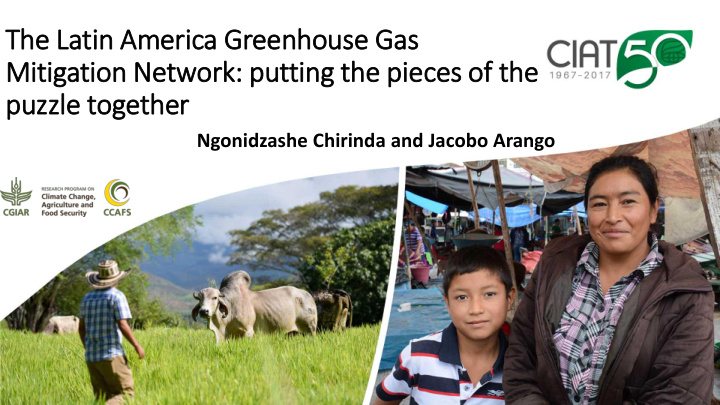



The Latin America Greenhouse Gas Mit itigation Network: putting the pie ieces of f the puzzle together Ngonidzashe Chirinda and Jacobo Arango
The Fisher et al 1994 carbon story Carbon increase compared to Native Savanna: • 25 Mg ha -1 in grass-alone Brachiaria pasture • 70 Mg ha -1 in grass-legume association of Brachiaria humidicola and Arachis pintoi
The Rao and Trujillo et al’s story on the origins of this carbon • Rao (1998) mean live standing root biomass (0-80 cm depth) for seasons • Improved grass alone pasture (5.7 Mg ha -1 ) vs .Native savanna (1.4 Mg ha -1 ) • Trujillo et al’s (1997) mean root biomass Improved grass alone pastures (8.6 Mg ha -1 y -1 ) vs. Native savanna (2.9 Mg ha -1 y -1 ) • • Why in some cases fertilizer applied at establishment and for maintenance • After 1 year remaining organic matter was 2.8 times higher under improved stand alone pastures compared to native savanna pastures
The Rincón and Flórez 2013 story: animal liveweight gains in the acid soil savannas of Colombia Animal liveweight gain 1200 1000 (kg/ha/year) 1000 800 600 600 450 400 110 200 27 0 Sabana nativa Native savanna Pasturas degradadas Degraded pasture Gramíneas/leguminosas Pastura con fertilizante Grass/legume pasture with fertilizer Pastura mejorada con maiz Improved pasture planted with maize Pastura despues de 3 años de rotación de maiz y soya Pasture after 3 years of maize-soybean rotation Rincón and Flórez (2013)
The Subarrao et al’s BNI story Some Brachiaria pastures produce root exudates that contain nitrification inhibitors Subbarao et al., 2009
The Byrnes et al. story on reducing N 2 O emissions from urine patches Brachiaria hybrid Mulato: low BNI vs. Bh CIAT 679 cv. Tully: high BNI BNI potential 250 (ATU per gram of root dry weigth) 200 BNI potential 150 100 50 0 N 2 O fluxes BM BT 0.5 N2O Flux (mg N2O-N m-2 h-1) 0.4 MULATO (Low BNI) 0.3 0.2 679 (high BNI) 0.1 0.0 -0.1 -1 0 1 2 3 8 10 15 17 24 Days after urine application
Infographic to have a sense on the importance of tropical pastures Brachiaria in Brazil Total Pasture in Brazil 99 Mha 190 Mha
A recent story on pasture degradation impacts on N 2 O emissions Brazil Colombia Argentina 1.6 0.024 1.4 0.022 Emission factor (%) 0.020 1.2 0.018 0.016 0.014 Emission factor (%) 1.0 0.012 0.010 0.8 0.008 0.006 Taluma - Colombia Manfredi - Argentina 0.6 0.4 Argentina 0.2 Adequate vegetative cover 0.0 Low vegetative cover Nicaragua Trinidad and Tobago Taluma - Colombia Manfredi - Argentina Balcarce - Argentina Patía - Colombia Rio Grande do Sul - Brazil Estelí - Nicaragua Chirinda et al., 2019
Infographic to have a sense on the importance of tropical pastures Brachiaria in Brazil Area of pasture Total Pasture in Brazil 99 Mha renewed each year 190 Mha 8 Mha
Catalyzing farmer innovations and the adoption of promising management and technological options to facilitate the development of low-carbon cattle value chains in Latin America
A snapshot on where we are now with this evolving story… • Studied Brachiaria pastures result in high C sequestration • Brachiaria pastures with high BNI potential decrease urine-based N 2 O emissions • Pasture degradation is bad for both animal productivity and urine-based N 2 O emission • More listening and well thought-out joint actions are needed to accelerate the necessary changes Thank you for this opportunity & your attention
References • Fisher, M.J., Rao, I.M., Ayarza, M.A., Lascano, C.E., Sanz, J.I.,Thomas, R.J., Vera, R.R., 1994. Carbon storage by introduced deep-rooted grasses in the South America savannas. Nature 371, 236 – 238. • Rao, I.M., 1998. Root distribution and production in native and introduced pastures in the South American savannas. In Root Demographics and their Efficiencies in Sustainable Agriculture, Grasslands and Forest Ecosystems (pp. 19-41). Springer Netherlands. • Rincón A; Flórez H. 2013. Sistemas integrados: Agrícola-ganadero-forestal, para el desarrollo de la Orinoquia colombiana. Manual técnico No. 17. Corpoica, Villavicencio, Colombia. • Subbarao GV; Nakahara K; Hurtado MP; Ono H; Moreta DE; Salcedo AF; Yoshihashi AT; Ishikawa T; Ishitani M; Ohnishi-Kameyama M; Yoshida M; Rondón M; Rao IM; Lascano CE; Berry WL; Ito O. 2009. Evidence for biological nitrification inhibition in Brachiaria pastures. Proceedings of the National Academy of Sciences of the United States of America 106:17302 – 17307. • Byrnes, R.C., Nùñez, J., Arenas, L., Rao, I., Trujillo, C., Alvarez, C., Arango, J ., Rasche, F., Chirinda, N ., 2017. Biological nitrification inhibition by Brachiaria grasses mitigates soil nitrous oxide emissions from bovine urine patches Soil Biology & Biochemistry 107, 156 – 163. • Chirinda N. , Loaiza, S., Arenas, L., Ruiz, V., Faverín, C., Alvarez C., , Savian, J.V., Belfon R., Zuniga K., Morales, L., Trujillo, C., Arango, M., Rao, I., Arango, J. , Peters, M., Rolando Barahona, R., Costa Junior C., Todd S. Rosenstock, T.S., Richards, M., Martinez-Baron D., Cardenas, L. 2019. Adequate vegetative cover decreases nitrous oxide emissions from cattle urine deposited in grazed pastures under rainy season conditions. Scientific Reports 9, 908 //doi.org/10.1038/s41598-018-37453-2.
Recommend
More recommend